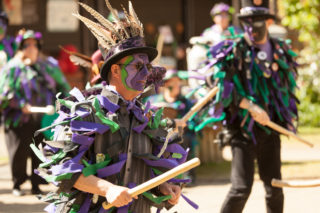Uncovering the story of local milling
Mill Green Museum and Mill
As part of the regional Traditional Hertfordshire project, Mill Green Mill and Museum ran a programme of activities and events linked to the heritage of milling, and other local crafts and traditions.
The Museum put together an exhibition titled Voices from the Mill which explored the sayings and phrases which originate from milling. A document of all the research sayings is attached below.
The exhibition also featured stories of Mill Green Millers, and how they were not always the most reputable members of the community!
Local people brought their grain to the miller to be ground into flour. The miller took a measure of the grain instead of payment, normally 1/16th of the bag. In 1482 two millers were fined for taking too large a share of grain from their customers. This was called taking excessive tolls.
The exhibition featured a popular weighing activity which expanded on account of millers occasionally leaning over the scales when weighing their sacks to make them appear heavier!
One of the highlights of the project was a major event day on Sunday 14th May for National Open Mills weekend. The event included storytelling, straw plaiting, bread and butter demonstrations, and guided tours around the mill. Visitors particularly enjoyed a Morris dancing demonstration by the Wicket Brood.
The museum set up an oral history programme as part of the project including recording two new oral histories. One was with one of the longest serving millers at Mill Green, Joe, which you can listen to a clip from at the top of this page.
The final part of the project at Mill Green Mill and Museum was running Young Millers days for local schools and colleges. Students got hands on in the mill bagging up flour and using the sack hoist. Then the young people learnt about bread making and baked their own loaf using flour milled on site.
Visitor and volunteer feedback about the project was really positive and it was a wonderful opportunity to better understand our local traditions.
For more information about the Regional Traditional Hertfordshire Project check out their website and follow the project on Facebook
Transcript:
Interviewer:
So, you, let’s have a look. What about… have there been any interesting incidents, since you’ve been here. apart from being filmed by the bbc? Since you’ve been a miller, have there been any interesting stories?
Joe
Stories, well. Hm, How true they are. And some of them have been a little bit… I’ve got accused of embellishing them somewhat when I was telling people the story. First of all you’ve got the Murdering Miller, who was a young man called Robert Rawson. Now he was the son of er… I think.. I forget his name now… anyway I think his father’s name was Robert as well. He had two other brothers, Luke, Luke is …. anyway, there were three brothers, and er Robert was the youngest one. Well Mr Rawson the miller was nearly always in dispute with the Bush Hall miller, a fellow called Mr Node, this guy who er and Bush Hall was a fulling mill. Now a fulling mill processes wool to make cloth, and they take water out of the river to do it. And they don’t put it back. Whereas we use the water and pass it on down to the next mill further downstream. Well the fulling mill takes water out of the river and er doesn’t replace it. So consequently sometimes Mr Rawson here was a bit short on water. So there was always rows about it. Well young Robert, Mr Node lived at Stevenage. That’s why you get the story from Stevenage museum slightly different. This Mr Node lived at Stevenage. Well, young Robert, he wanted to um, er help his dad out, and he had a nice big burly friend, called George North. And so he and George one day, they went over to the stables, saddled up their horses. Off they went up the A1, old old Great North Road there to Stevenage. And they found MR Node there and confronted him and had a bit of a row, well young Robert, was a bit of a hot headed young man. He had taken a c(r)udgel with him. And in the ensuing row, he bonked Mr Node over the head with it, and on.. and unfortunately killed him. So poor old George, he got tried by the local beaks in, in Stevenage presumably and, er, paid the penalty, but young Robert,because he was an educated young man, he got the benefit of clergy. i.e. he could read the bible in Latin. So he got tried by up at the Bishop’s court, in Hatfield. And because he was an educated man, what he got, he got an M branded on his thumb. And that was it. He got away with it. But, in his…. when his father died, everything went to the.. we’ve got a copy of his father’s will… everything was left to his wife. And when Mrs Rawson died, everything, m… when she died, things w…. er in her will, all her other sons were mentioned, but Robert wasn’t. So we don’t actually know what happened to Robert, because, when you get the story from Stevenage, Robert is the Murdering Miller of Mill Green, well he never was the miller here. `His brother Luke was, And what, so we don’t actually know what happened to Robert, but he wasn’t mentioned in his mother’s will. So he could have died or… whatever, we don’t know.












Add your comment about this page
Ere! Trouble at Mill.